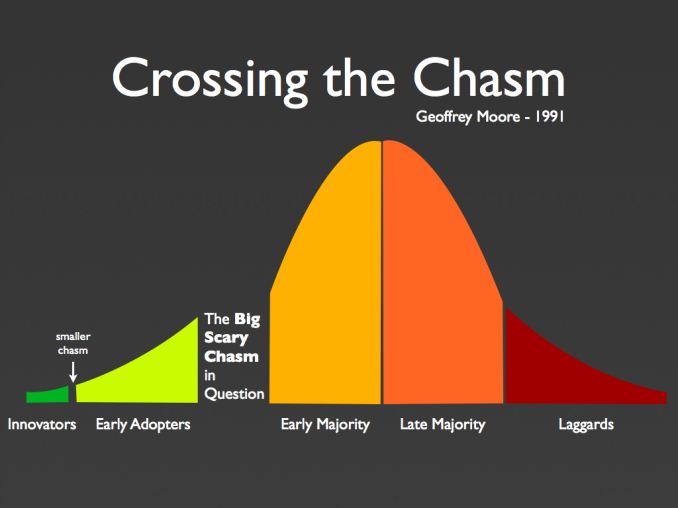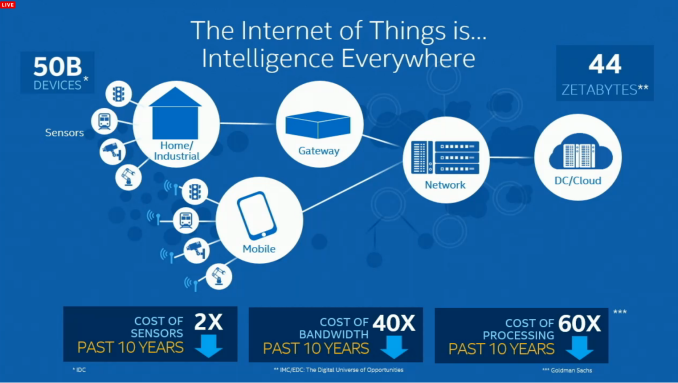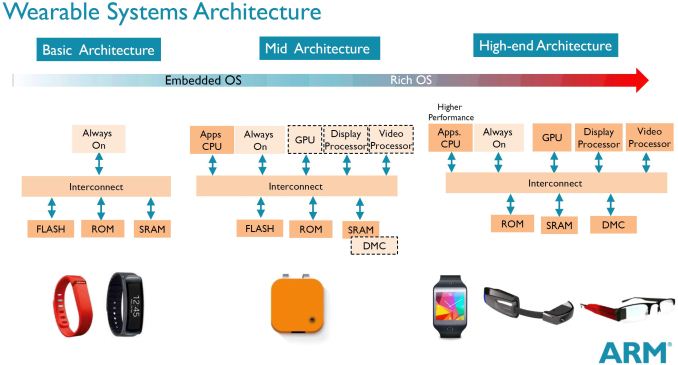Wearables: 2014 and Beyond
by Stephen Barrett on January 15, 2015 11:50 AM EST- Posted in
- Wearables
- Apple
- Microsoft
- pebble
- Android Wear
- Microsoft Band
- Fitbit

As the year 2014 has come to a close, now is a good time to inventory changes in the consumer electronics market and project those trends forward. One of the most obvious changes was that wearable technology has, by my observation, approached the brink of the adoption chasm into the early majority. In this article we will focus on the significant business and consumer factors of wearable technology, the notable introductions in 2014, as well as future AnandTech coverage.
If you are unfamiliar with ‘the chasm’, this is a reference to an acclaimed technology marketing book by Geoffrey A. Moore in 1991. As seen in the figure below, Geoffrey describes five stages of adoption.
The first, consumers described as innovators, are on the very bleeding edge. Innovators have a combination of unique interest in the subject area and abundant disposable income. There is a small chasm between this group and the next. This small chasm has killed many technologies and you could probably argue that 3D TVs died here. Next, early adopters are more like typical AnandTech readers. These consumers are technologically savvy and often the technology go-to person for groups of family and friends. Early adopters are likely to have made investments into products that their friends have yet to invest in themselves. My wife described me this way when I made the jump from iPhone to Windows Phone. It was an early product without majority adoption (and still is), but I wanted it anyway.
This brings us to The Big Scary Chasm in Question. How does a technology explode from a “hobby”, as famously Apple described its Apple TV, to a staple like the iPhone? In the information age of today, crossing this chasm is primarily a focus of marketing. Sure, you need good product, but without effective marketing there is little chance of wide adoption. There are plenty examples of products that have been favorably reviewed by AnandTech and others but didn't see widespread adoption. Often, it's a case of competing against the marketing budget of a much larger company, but that's a topic for another day. In short, going from a cult hit to a market leader is difficult; hence, the Chasm.
Taking this back to wearables, 2014 saw the most marketing of wearables yet, and for good reason. The traditionally explosive smartphone and tablet markets are slowing down. Analysts at CCS Insight projected a fall of smartphone sales' yearly growth from 40% in 2013 to 25% in 2014 and 15% in 2015. Analysts at Gartner project a fall of tablet sales' yearly growth from 55% in 2013 to 11% in 2014. IDC projects 2014 tablet growth even worse at 7%. At the same time, wearable revenue is projected to dramatically grow. ABI Research projects wearable technology at a compound annual growth rate (CAGR) of 56.1% over the next five years. Finally, Price Waterhouse Coopers’ interview samples show that 76% of consumers do not need a new wearable device to replace functionality of an existing device.
The top consumer eco system players – Apple, Microsoft, Google, and Google’s partners – are growth companies. Continually increasing revenue is a corporate foundation. Without revenue growth, careers stagnate as no promotions or raises are possible. Go long enough without growth and your top talent can leave for a company with growth opportunity. In Samsung’s recent 3rd Quarter financial results, their revenue fell 20% year over year and Samsung primarily attributed this to smartphone struggles.
With all this data combined, it is a no-brainer for these consumer companies to shift resources to wearables. Therefore, all have made significant wearable announcements. Google’s partners and Microsoft have launched devices while Apple is alone in the laggard position of having nothing on the market (with Apple Watch coming this year).
Wearables: What Are They?
At their core, wearables are of course technological devices that you wear. In some sense, your smartphone is actually a wearable. Even though a smartphone usually does not directly contact your body, it is a wearable just as much as a smart purse or backpack is a wearable. However, as smartphones are already a category of their own, they are traditionally excluded even though the core technology is vastly similar. That core technology consists of sensors, wireless, storage and computing. Intel’s recent IoT (Internet of Things) platform launch contained a slide detailing the cost reduction of some of these components, which is an enabling factor of wearable growth.
Where wearables differ from smartphones is their function. By breaking from the traditional smartphone form factor a wearable can provide different benefits. These benefits can be broken down into different categories that closely mirror the contents of the device as different sensors, processors, wireless, and storage enable different use cases.
On the left side of the above diagram from ARM are devices that contain wireless connectivity, sensors, a low power microcontroller such as Coretex-M, small amounts of memory and storage; run an embedded OS; and potentially have an optional display. The vast majority of these devices today are for fitness and health, however some provide smart watch functionality as well. On the middle and right side of the diagram are devices that integrate higher end processing and storage such as full-blown application processors (think Cortex-A series) and DDR memory. These allow running richer, non-embedded operating systems (such as Android) and higher-end features at the cost of power consumption.













79 Comments
View All Comments
mkozakewich - Friday, January 16, 2015 - link
Ooh, and make sure to call out the density of the display. There's no reason to be using 100dpi screens, for example.wyx087 - Friday, January 16, 2015 - link
Cost is always something that gets mentioned. I don't get it. Watch is a jewelry in addition to time teller. To buy a good classic watch, you will need to spend £100/$100 to thousands. As an adult, why would you want to be seen wearing a plastic G-shock watch?I used to wear a selection of Swiss watches. But I long for phone notifications on my wrist. While Pebble Steel was far from perfect in terms of style, it's the closest thing you can get to a watch replacement:
- Always-on display
- Basic handling of notifications
- View calendar and reminders
- Days up to a week of battery-life
What is ideal is a round smartwatch with thin edges for the always-on e-ink display. Moto 360 was very tempting for its styling, but the battery life and display shows it's not a watch replacement. In fact, a Swiss styled mechanical watch with notification display in the background would be the perfect classic watch replacement. It'll last weeks because there's no silly sensors.
So while your use-cases are good. But I think a 4th can be added (or the smartwatch use-case can be adopted): Watch replacement. A smartwatch doesn't need to have that killer app, just saving the few seconds of bringing up a phone is more than enough. To replace a jewelry the device needs to be a jewelry, the electronics inside isn't as important.
Arbie - Friday, January 16, 2015 - link
Great article! Thoughtful, well-presented in depth, and relevant. Lets have more of this caliber.Thanks.
ithehappy - Friday, January 16, 2015 - link
The only one I like here is the Gear Fit. But then again its fully compatible with Samsung phones only, which is a shame.I am looking forward for the Lenovo e-Ink one which will come out at March.
PS: I am a regular watch wearer by the way, automatics, so no, I am not nearly crazy enough to replace my watch with these toys, I just need one to have notifications on my wrist.
HisDivineOrder - Friday, January 16, 2015 - link
Far from the fargone conclusion, I find the Apple Watch and other wearables to be answering a problem no one had with a solution the majority have rejected in prior decades. People don't wear watches. They don't like being reminded by this thing strapped to your wrist of the finite amount of time they have, so why would they want to wear a watch?I think for wearables to work, they must follow in the way of smartphones and improve something that people already do. Tablets worked because they essentially cribbed off smartphones, but made it bigger and said, "You know you how you used to read a book? Now you can read a tablet."
That's it.
When you look at watches, it's like the argument is they want phones to be so large you don't want to get them out, which seems like they're just undermining phones to make watches more relevant.
And people already didn't want to wear watches. So they'll just keep buying smaller phones instead. I think something like Google Glass or even just a pair of sunglasses with voice recognition and a bluetooth connection to your phone will likely work a LOT better.
Mostly because who doesn't wear glasses? Either prescription glasses or sunglasses... just about everyone wears glasses of some sort.
BuddyRich - Saturday, January 17, 2015 - link
A round pebble steel with wireless charging (though the magnetic induction is better than a regular cable) and I would be sold.Its pricey but I am also interested in the Withings Activite. One of the only companies to take design seriously. Swiss movement mechanical watch that does step tracking, lap swimming, etc. Only thing its missing is some sort of notification light. 8 months battery life. If you don't want the quality you can get the visually identical Activite Pop without swiss movement, sapphire crystal or leather strap. Only thing is, this really is more of a fitness only watch vs. a "smart" watch.
As for smart watch reviews.... Battery Life test (of different modes), daylight readability, nighttime readability (including tests for backlit devices to test if its too bright say in a movie theatre to be always on). Functionality of course and phone interoperability (ie. all functions available paired with iOS vs. paired with Android and what specific phones - Samsung wearables sometimes only fully support Samsung phones). Pairing issues itself.
Lots of photos because style is much more important, on a variety of wrists, perhaps showing what it would look like on a female's wrist for comparison to gauge size.
I am not sure what the use case for a smart watch is, other than to tell time. Im the sort of person who hates using blutooth headset in public (and am annoyed by others that do) so I am not sure I would ever speak to my watch a la dick tracy, but a notification light might be handy, maybe something to pause music or the apple tv when at home, etc.
Tams80 - Sunday, January 18, 2015 - link
The date and day on the Activite appears to be missing. It may seem like a very minor thing, but that is something that makes me hesitant about switching from my current watch. They also don't seem to mention how long the device can function away from a smartphone.Using their heart rate and blood oxygen sensors wouldn't be feasible in such a package, but it would be nice if they made a companion device that's sole purpose was to continuously track them.
MADPhoenix - Sunday, January 18, 2015 - link
Good article. One device that seems to be overlooked (and I think it's fine) was the sixth generation iPod nano (the square one). It wasn't directly a watch but they made a band for it so you could wear it like one. Even the lock screen was an analog clock face.aggiechase37 - Monday, January 19, 2015 - link
Not interested in the goofy watches. Not interested in the glasses because they look silly. Make me some shades that look like shades and we could talk. Until then, I'm all set for my trusty smartphone, my laptop, and my custom built desktop. All this wearable crap seems like a desperate play for growth by these big companies when there really isn't demand for something like that.I don't know a single person who thinks they need a smartwatch. By contrast, when smartphones were first taking off everyone was talking about how they wanted it. On a smartwatch's best day, the reaction is, "neat, but I'll pass."
I do however think there could be a market for the glasses, but not until they don't look like something the doc from Back to the Future would wear. Until then, I'm out.
eric678 - Monday, January 19, 2015 - link
You left out mybasis peak - my current wearable. I like it - mostly a basic watch that tracks everything I want to, but has HR and a good app/web dashboard to analyze.